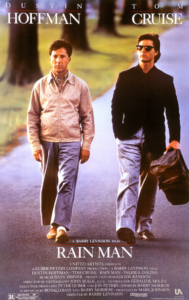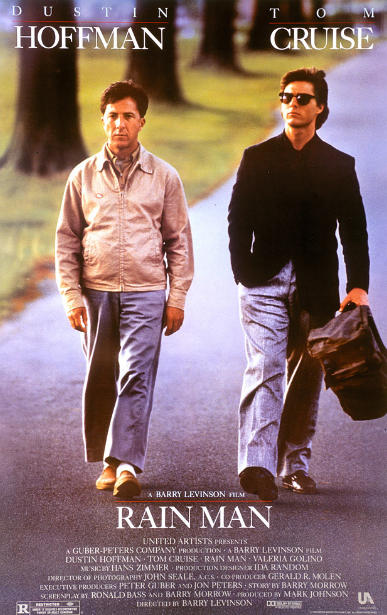The 1988 Academy Award-winning movie Rain Man is inspired by the real-life individual Kim Peek. Dubbed a “walking encyclopedia,” Peek is said to have memorized over 10,000 books. While the United States boasts Kim Peek, the United Kingdom has its own prodigy, Daniel Tammet. These two met in 2004 at the Salt Lake City Public Library in the US. When Tammet introduced himself, saying, “I was born on January 31, 1979,” Kim Peek replied, “Your 65th birthday will be on a Sunday. My birthday is November 11, 1951.” Tamet responded, “So, you were born on a Sunday, too.”
Among individuals with autism, some possess innate extraordinary memory or artistic abilities. They can memorize anything they’ve seen just once. Dustin Hoffman’s character in Rain Man is such an individual. The movie depicts the relationship between an autistic man (Dustin Hoffman) and his selfish younger brother (Tom Cruise). Upon learning that their father’s $3 million inheritance was left to his elder brother, the younger brother seeks out the ‘Rain Man’ he used to call his brother, in order to share the inheritance. Discovering his brother’s remarkable ability to remember every number he has ever seen, they head to a Las Vegas casino to play blackjack. With Rain Man’s ability to memorize all the cards’ numbers and suits, the outcome is inevitable.

Daniel Tammet, also known as “Brain Man” in the UK, is a genius who also suffers from autism. Tammet has published an autobiography titled “Born on a Blue Day (2006)” that contains his thoughts. He might be the only person who can express the mental world of autism on his own. He has openly discussed his issues with social interactions, saying, “Once I start talking, I go on without stopping, not giving myself a moment to breathe or the other person a chance to speak. I never even considered the need to pause during a conversation.”
Our brains receive an enormous amount of information every moment. The information we consciously seek is just the tip of the iceberg compared to what our subconscious absorbs. According to psychologist Timothy Wilson in “Strangers to Ourselves,” our senses process up to 11 million pieces of information per second. A movie is about 1 gigabyte in size, which can be stored on one or two CDs. However, if we were to store a day’s worth of experiences as video and audio on a computer, it would easily exceed several tens of gigabytes. Even high-performance computers can only store a few days of our lives.
Yet, our brains remember most of our lives, even if selectively. We might not recall everyday moments on our own, but encountering something that triggers a memory can bring those moments back to mind. Where is all this information stored? There’s no need to worry; our brain’s storage capacity is about 100 terabytes. Even if our PC’s hard disk has more than 100 gigabytes, considering a gigabyte is 10^9 and a terabyte is 10^12, our capacity is about 1,000 times larger. However, this number is not based on solid scientific evidence or authority; calculations vary, and so do the results. The figure of 100 terabytes, or 100 trillion, is just one of many claims. Considering our synapses number around 100 trillion, this estimate isn’t entirely baseless.
There’s no need to fall into the trap of numbers; it’s enough to understand that our memory capacity is significant. If this still seems unrealistic, consider that the average person’s memory capacity could fill the Library of Congress, the world’s largest library, with its 20 million volumes of books. It’s not easy to imagine filling this space with books about our daily lives and everything we’ve read.
Although we only use a fraction of our brain’s capacity, the amount of information we’ve processed is substantial. If we could utilize all the knowledge and information we learned in school, we’d all be considered geniuses. Unfortunately, we only remember a small portion. Strictly speaking, it’s not that we forget; we just can’t find it. Just like deleting a file on a computer’s hard disk doesn’t erase the data (since it’s stored magnetically), memories are not erased; we just can’t find the “file name” to recall them. Failing to recall information during a test is not a sign of forgetting but a failure to retrieve it.
Many people fall into one of two traps related to memory. Some dismiss memorization as something only unintelligent people do, insisting that “understanding is enough.” While understanding is a necessary step for remembering, failing to memorize key words can make acquiring new knowledge difficult. Even if we understand a joke and laugh heartily, if we don’t memorize the words that compose it, it’s hard to use it ourselves later. This applies to most knowledge.
Understanding naturally strengthens the memory of some words, but usually only those we’re already familiar with. If we can’t recall something when needed, its utility is questionable. Memory is essential for maintaining daily life and relying on accumulated knowledge to solve problems. Life is a series of memories, and our efficiency and excellence depend on them. Meetings with people also proceed through memory. Even if we’re not quoting poetry or movie lines effortlessly, conscious memorization is necessary for daily life.
Yet, many people overlook the process of memorization for memory, falling into a trap. There are many reasons for this, including those who give up memorizing early, believing their memory is inferior, and those who think remembering too much will cause confusion. Our memory can hold the equivalent of 20 million books, so the idea that “too much to remember” doesn’t apply. Memorizing more can actually strengthen memories and lead to new, creative knowledge.
Another trap related to memory is believing that mindless repetition is the best way to memorize. While repetition is indeed a crucial element in memory, evidence is plentiful that it enables the human brain to remember better. However, without understanding, all knowledge can only be stored as fragmented and isolated. Essentially, each word is remembered as a meaningless piece of information that must be pulled out one by one. It must be mentioned again that the amount of information one can remember increases when it can be recalled through experiences or stories.
Organizing is also essential for good memory. The act of organizing itself saves time paradoxically, even though it may be time-consuming because it reduces the time spent searching for something. Someone once said, “Half of our lives is spent searching.” While we cannot take this statement at face value, it is true that we spend a considerable amount of time searching for things. There are instances where searching for data to write a single line can take hours. Currently, the internet is a valuable tool, and many people have organized necessary information there. Without someone’s help in organizing, no task can move forward.
The human brain contains about 100 billion neurons, closely interconnected to perform complex functions like memory, language, and emotions. These connections in the brain are called synapses, the pathways for neural information transmission. A single neuron is known to connect with 5,000 to 10,000 other neurons. Essentially, our brain’s structure is a network, similar to how humans and nature are interconnected. In 1949, Canadian psychologist Donald Hebb proposed that ‘memory is the strengthening of synapses, activating multiple neurons.’ Subsequent experiments by other scholars have verified Hebb’s claim. To remember information, it’s not that new neurons are created, but the connections between neurons strengthen, forming a network.

Thus, every time we are born into this world and accept new knowledge, we are connecting our neurons. Think of the expression, “One thought leads to another.” This might be why Daniel Tammet from “Born on a Blue Day” continues to talk without pausing once he starts. Because he remembers so much of what he sees and reads, hearing a word or name during a conversation might trigger a domino effect of associations, leading to new words emerging.
If we were to depict memories following one after another as an image, it would likely resemble a network. It means that a memory is not just attached to a single tail. In fact, the network of neurons resembles most networks that exist in the world. Imagine the cities of the world connected by airplane routes. Most cities are now connected to at least one other city, with major cities like New York or Paris linked to most other major cities.
Moreover, our neurons are known to form new connections whenever we think. According to a research result submitted to “Science” on Feb 29, 2008, by Professor Kang Bong-kyun’s memory control research team at Seoul National University, we ‘rebuild the house of memory’ each time we recall old memories. This means that the network of synapses, the location where old memories are stored, is dismantled and reassembled during the recollection process, allowing past memories to be reorganized by recent ones.
This phenomenon is similar when absorbing new information or knowledge. It can be likened to the aviation network becoming increasingly complex with new routes, and the routes between cities with frequent exchanges becoming stronger. It is important to note that our cells, thoughts, relationships, nature, and the universe are all part of a similar network structure. If the complex world we encounter is all of this form, understanding one aspect could serve as a steppingstone to understanding other complexities.


답글 남기기